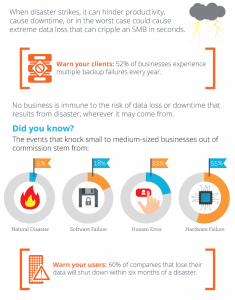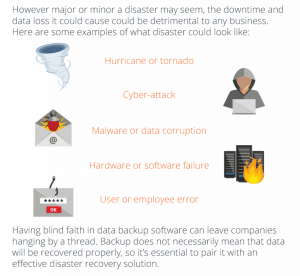 What is Backup and Disaster Recovery (BDR)?
What is Backup and Disaster Recovery (BDR)?
Disaster recovery (DR) of backups involves policies, procedures, and deployment to recover data or the continuation technology infrastructure, systems and data following a data loss caused by a disaster. Disaster recovery focuses on the technology systems supporting critical business functions. Disaster recovery is, therefore, a subset of business continuity.
 Having a backup of your critical files is not enough enough! Most conventional backup solutions such as NAS, external hard drives, backup to servers or cloud backups are better than nothing but can leave you wondering what to do with your business while waiting on the data to be restored!
Having a backup of your critical files is not enough enough! Most conventional backup solutions such as NAS, external hard drives, backup to servers or cloud backups are better than nothing but can leave you wondering what to do with your business while waiting on the data to be restored!
Keep in mind the terms “Backup” and “Disaster Recovery” are not interchangeable. Disaster recovery, however, is not possible without first having a completed backup. Disaster recovery is actually having the backups and resources in place to get systems restored and functioning as quickly as possible. This including backed up data along with user accounts, programs, operation systems, customer facing systems, etc.
On a side note, disaster recovery is cheaper, quicker, easier, and more complete with virtual systems in place.
Also note that the above descriptions obviously don’t get into technical details. Any and all Backup and Disaster Recovery solutions are usually unique to a business or operation.
Disasters are not predictable, but you can plan to alleviate their effects. Disasters can come in different forms such as fires, floods, human error, server crashes, viruses, or hacking attacks, so you want to have a plan in place to improve resiliency and ensure recovery of your business.
Planning is about taking responsibility, assessing risk, and planning to keep your business in business at all times. The Business Continuity Institute defines BDR as “having a plan to deal with difficult situations, so your organization can continue to function with as little disruption as possible.”
It is a growing business as companies have downtime that is expensive. The two leading causes of data loss are hardware and software failures. The only way forward is to be prepared for such an eventuality and maintain data integrity by employing appropriate mechanisms to detect and remedy data corruption. The Disaster Recovery as a Service (DRaas) is estimated to grow from $1.42 Billion Dollars (2015) to $11.92 Billion in 2020.

- 55% of data loss is due to hardware error
- 22% of data loss is due to human error
- 18% of data loss is due to software failure
- 5% of data loss is due to natural disaster
Often business cannot recover from a data loss 60% of business that lose data shut down within six months a data loss disaster.
Reasons for a disaster vary but can be related to natural disasters, cyber attacks, malware, viruses, data corruption, software error, hardware failure, human error, or intentional data destruction. Human error and natural disasters are inevitable.
 How long can you afford to be without your line of business application or critical data? If you are using conventional or cloud backups I have seen customers waiting for days to access their data to get your their business running again!
How long can you afford to be without your line of business application or critical data? If you are using conventional or cloud backups I have seen customers waiting for days to access their data to get your their business running again!
The horrible truth about backup: in today’s world of ever-growing data storage I see conventional backups either failing to retain critical data, failure to have backups that work, failure to have a way to restore data, or taking too long to restore data. Now is the best time to evaluate your backup and disaster recovery plan. Without the proper backup and disaster recovery plan in place, you could be waiting for days or even weeks to replace your server and the critical data for your business.
